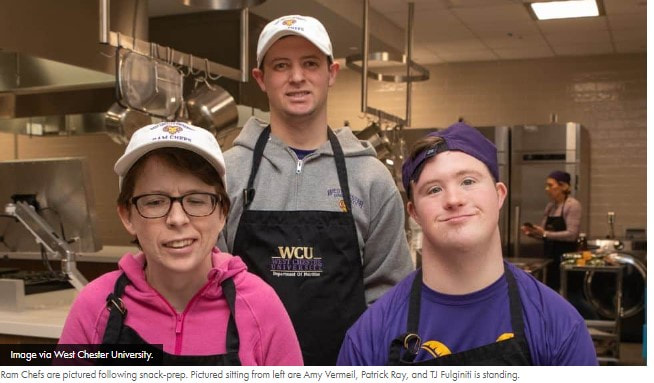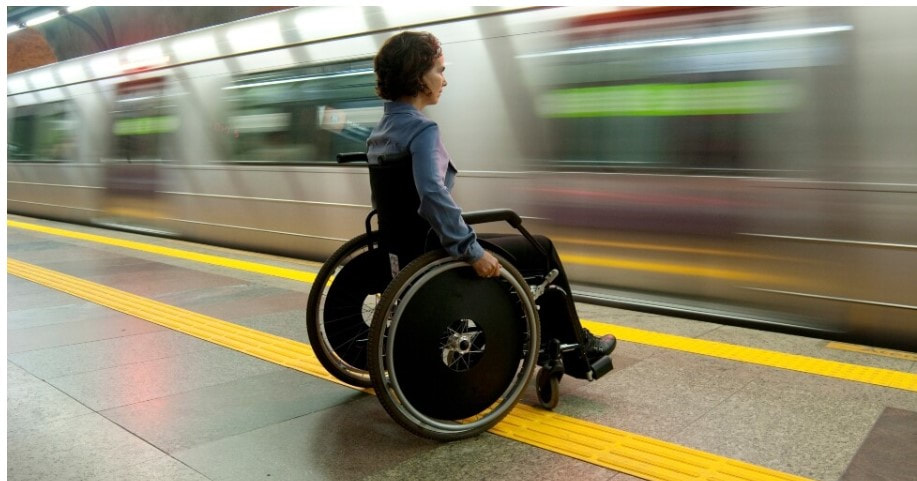by Massarah Mikati, The Philadelphia Inquirer/TNS | January 16, 2024
Philadelphia has been named the first sensory-inclusive city in the country.
The city is the first to receive a Sensory Inclusive Certification from KultureCity, a nonprofit focused on sensory accessibility nationwide. The Alabama-based organization provides the certification, along with training and resources, upon receiving applications.
“Philadelphia has the highest rate of disability among the top large U.S. cities at nearly 17%, and this includes those with sensory-based disabilities,” Amy Nieves, executive director of the Mayor’s Office for People with Disabilities, said at a recent press conference. “One in six people in our nation have a sensory-related disability … and we all need more understanding in how we engage and communicate, ensuring that all are welcome.”
People who tend to have sensory-based disabilities include those with autism, ADHD, post-traumatic stress disorder, or those who are neurodiverse, officials said at the press conference.
The certification process included training over 70% of city workers — over 16,000 people — in sensory inclusivity, as well as providing resources for those with sensory disabilities in the new year. Those resources include mobile stations with tactile sensory objects and other tools for people with sensory disabilities to use if they’re feeling overwhelmed in their environment, as well as sensory bags, which will be stocked with visual cue cards for people who are nonverbal, headphones to muffle loud noises, and fidget tools to aid with restlessness. They will be available for use at a variety of events as soon as early this year, Nieves said. She said no verification of disability will be required to use the resources available.
In addition to the city, all of Philadelphia’s professional sports teams are certified as sensory-inclusive teams and venues by KultureCity. That certification process began in 2019 for the Eagles, who wanted to create one of the first sensory rooms in the NFL, which is located on the west lower suite level at Lincoln Financial Field.
“Our goal was to recognize an environment that cheering on your favorite NFL team could be a bit overwhelming, and to provide families with an opportunity to take a break in a situation where there was a no-reentry rule,” said Ryan Hammond, executive director of the Eagles Autism Challenge. “We recognize that it takes all of us to advance our collective mission of helping people with disabilities live their best life today.”
The need for more accessibility
The recent announcement, however, left some in the disability community confused and skeptical.
“I wondered why such an amorphous kind of idea got such traction, when I’ve noticed other people with more overt disabilities don’t seem to be getting ahead,” said David Wannop, who is blind.
Every few days, Wannop said, he’s hearing about a friend or acquaintance with a physical disability running into accessibility issues.
“There’s just so much that doesn’t get done with the maintenance of wheelchair access,” Wannop said. “And I can’t tell you how often the law
has said I deserve Braille materials, but none are in the offering in real terms.”
Nieves said that the city recognizes disability is not a monolithic experience, and they are committed to hearing feedback from community members to continue to make Philadelphia a welcoming space for all.
“The city’s work to promote sensory inclusion is not about focusing on only one aspect of disability inclusion but making sure that no matter how we move our bodies, utilize our minds, communicate, or lift our voices, we are all welcome here and deserve to feel a sense of belonging,” she wrote in an email to The Inquirer.
Wannop added that he was concerned about people abusing the available resources if there’s no verification method, akin to when emotional support animals became popular and made it more difficult for people with trained service animals to access spaces.
Similarly, Vicki Landers, founder and executive director of the nonprofit Disability Pride Pennsylvania, said that while she’s really happy with the general work being done by the disabilities office, she would like to see more attention paid to people with other disabilities. For example, she says, the worst curb cut in the city for people with mobility disabilities is at City Hall.
“I don’t want to discount sensory-friendly, because I need those spaces too sometimes. But I feel like the conversation is just too much about sensory-friendly,” Landers said, adding that she has seen attention to autism and sensory-related disabilities become a trend over the past six years or so.
“As a person who has a nonprofit who works with all disabilities, the funding is tough if you’re not specifically talking to the autism community. That’s just where the money goes,” she continued. “But we’re talking to people with all different disabilities.”
Landers added that labeling the entire city as sensory-inclusive seemed misleading. “If you want to say that we did training with the City of Philadelphia’s employees, yes, that would make more sense,” she said. “But you can’t call us a sensory-friendly city, because guess what? You’re not.”
© 2024 The Philadelphia Inquirer
Distributed by Tribune Content Agency, LLC
The city is the first to receive a Sensory Inclusive Certification from KultureCity, a nonprofit focused on sensory accessibility nationwide. The Alabama-based organization provides the certification, along with training and resources, upon receiving applications.
“Philadelphia has the highest rate of disability among the top large U.S. cities at nearly 17%, and this includes those with sensory-based disabilities,” Amy Nieves, executive director of the Mayor’s Office for People with Disabilities, said at a recent press conference. “One in six people in our nation have a sensory-related disability … and we all need more understanding in how we engage and communicate, ensuring that all are welcome.”
People who tend to have sensory-based disabilities include those with autism, ADHD, post-traumatic stress disorder, or those who are neurodiverse, officials said at the press conference.
The certification process included training over 70% of city workers — over 16,000 people — in sensory inclusivity, as well as providing resources for those with sensory disabilities in the new year. Those resources include mobile stations with tactile sensory objects and other tools for people with sensory disabilities to use if they’re feeling overwhelmed in their environment, as well as sensory bags, which will be stocked with visual cue cards for people who are nonverbal, headphones to muffle loud noises, and fidget tools to aid with restlessness. They will be available for use at a variety of events as soon as early this year, Nieves said. She said no verification of disability will be required to use the resources available.
In addition to the city, all of Philadelphia’s professional sports teams are certified as sensory-inclusive teams and venues by KultureCity. That certification process began in 2019 for the Eagles, who wanted to create one of the first sensory rooms in the NFL, which is located on the west lower suite level at Lincoln Financial Field.
“Our goal was to recognize an environment that cheering on your favorite NFL team could be a bit overwhelming, and to provide families with an opportunity to take a break in a situation where there was a no-reentry rule,” said Ryan Hammond, executive director of the Eagles Autism Challenge. “We recognize that it takes all of us to advance our collective mission of helping people with disabilities live their best life today.”
The need for more accessibility
The recent announcement, however, left some in the disability community confused and skeptical.
“I wondered why such an amorphous kind of idea got such traction, when I’ve noticed other people with more overt disabilities don’t seem to be getting ahead,” said David Wannop, who is blind.
Every few days, Wannop said, he’s hearing about a friend or acquaintance with a physical disability running into accessibility issues.
“There’s just so much that doesn’t get done with the maintenance of wheelchair access,” Wannop said. “And I can’t tell you how often the law
has said I deserve Braille materials, but none are in the offering in real terms.”
Nieves said that the city recognizes disability is not a monolithic experience, and they are committed to hearing feedback from community members to continue to make Philadelphia a welcoming space for all.
“The city’s work to promote sensory inclusion is not about focusing on only one aspect of disability inclusion but making sure that no matter how we move our bodies, utilize our minds, communicate, or lift our voices, we are all welcome here and deserve to feel a sense of belonging,” she wrote in an email to The Inquirer.
Wannop added that he was concerned about people abusing the available resources if there’s no verification method, akin to when emotional support animals became popular and made it more difficult for people with trained service animals to access spaces.
Similarly, Vicki Landers, founder and executive director of the nonprofit Disability Pride Pennsylvania, said that while she’s really happy with the general work being done by the disabilities office, she would like to see more attention paid to people with other disabilities. For example, she says, the worst curb cut in the city for people with mobility disabilities is at City Hall.
“I don’t want to discount sensory-friendly, because I need those spaces too sometimes. But I feel like the conversation is just too much about sensory-friendly,” Landers said, adding that she has seen attention to autism and sensory-related disabilities become a trend over the past six years or so.
“As a person who has a nonprofit who works with all disabilities, the funding is tough if you’re not specifically talking to the autism community. That’s just where the money goes,” she continued. “But we’re talking to people with all different disabilities.”
Landers added that labeling the entire city as sensory-inclusive seemed misleading. “If you want to say that we did training with the City of Philadelphia’s employees, yes, that would make more sense,” she said. “But you can’t call us a sensory-friendly city, because guess what? You’re not.”
© 2024 The Philadelphia Inquirer
Distributed by Tribune Content Agency, LLC




